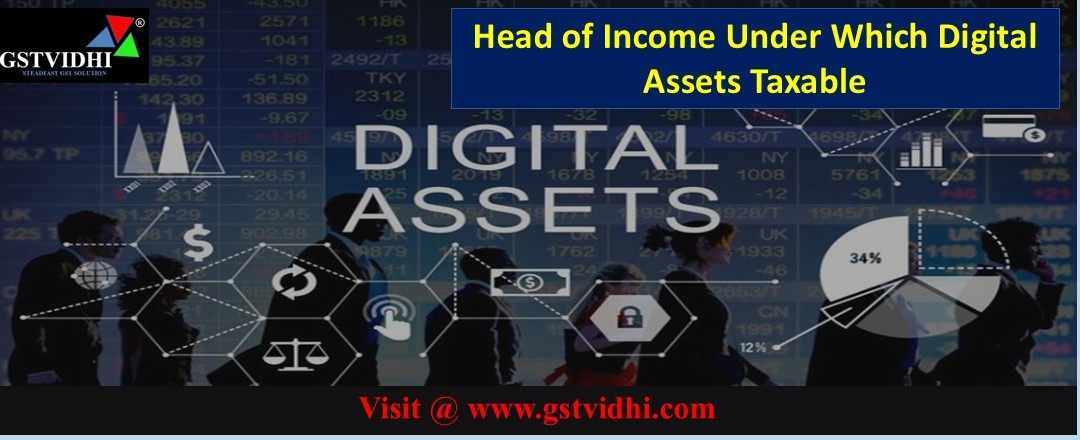
Head of Income Under Which Digital Assets Taxable & Taxation
on Transfer of Digital Assets
Introduction
With the rise of
cryptocurrencies, NFTs (Non-Fungible Tokens), and other blockchain-based
digital assets, India has introduced a specific taxation framework to govern
Virtual Digital Assets (VDAs). As the volume and value of these transactions
grow, it becomes important to understand under which head of income such
gains are taxed and how they are treated under the Income Tax Act, 1961.
What Are
Virtual Digital Assets (VDAs)
The Finance Act, 2022
introduced a legal definition of Virtual Digital Assets under Section
2(47A) of the Income Tax Act. This includes:
- Cryptocurrencies (like Bitcoin,
Ethereum)
- NFTs
- Any other digital tokens or assets
notified by the Government
These assets are not
treated as currency by law, but rather as a form of property or asset subject
to specific tax rules.
Heads of
Income Applicable to Digital Assets
The gains or income from
VDAs can be taxed under three heads depending on the nature and frequency of
transactions:
1. Income
from Business or Profession
If a person regularly
trades in cryptocurrencies or other digital assets, the profits will be
taxed under the head “Business Income.”
Criteria:
- Frequent buying/selling of digital
assets
- Treated as stock-in-trade
- Active trading as part of business
activity
Tax Treatment:
- Income is net of acquisition cost
- Taxed at 30% flat rate under
Section 115BBH
- Plus applicable surcharge and cess
Example:
If 1,000 NFTs are bought at ₹1,400 and sold at ₹1,700, total gain = ₹3,00,000.
This will be taxed at 30% = ₹90,000 + surcharge & cess.
2. Capital
Gains
When digital assets are purchased
for investment and held for some time before selling, they are treated as capital
assets under Section 2(14).
Criteria:
- Not traded regularly
- Held for long-term investment
- Sold after a reasonable holding
period
Classification:
- Long-Term Capital Gain (LTCG):
If held for more than 36 months
- Short-Term Capital Gain (STCG):
If held up to 36 months
Tax Treatment:
- Gains (Sale Price - Cost of
Acquisition) are taxed at 30% flat rate (no indexation allowed), as
per Section 115BBH
- No differentiation in tax rate for
LTCG or STCG
- No deduction for any expense (except
cost of acquisition)
Example:
If Bitcoin is bought for ₹4 lakh in 2017 and sold for ₹6.20 lakh in 2022, gain
of ₹1.20 lakh is treated as LTCG, taxed at 30%.
3. Income
from Other Sources
Where digital asset
transactions are occasional or stray, or involve mining or gifts,
they fall under the head “Income from Other Sources” under Section
56(2)(x).
Applicable in cases of:
- Mining of cryptocurrencies
- Gifts of digital assets
- Occasional transactions not part of
business or investment
Tax Treatment:
- Entire value (net of acquisition
cost) taxed at 30% flat rate
- No deductions allowed
- Applicable surcharge and cess apply
Example:
If 2,000 NFTs gifted to an individual are sold for ₹4,00,000, this amount is
taxed under Income from Other Sources.
Important
Points to Remember
- No Deduction
allowed for any expenses or losses against VDA gains.
- No Set-off
of losses from VDAs against any other income.
- TDS @1%
is applicable on transfer of VDAs where consideration exceeds ₹10,000
(₹50,000 in some cases).
- Losses from VDAs
cannot be carried forward or set off against gains from other heads.
Conclusion
The taxation of Virtual
Digital Assets in India has evolved with specific provisions aimed at ensuring
transparency and compliance. Whether the gains from digital assets are taxed
under Business Income, Capital Gains, or Income from Other
Sources depends on the nature of transaction, frequency, and intention
of the taxpayer.
Understanding the correct
head of income and tax implications is crucial to avoid penalties and optimize
tax liability. Taxpayers dealing in VDAs must also keep proper documentation of
purchase, sale, and holding periods to support their tax positions.
Disclaimer: All the Information is based on the notification, circular advisory and order issued by the Govt. authority and judgement delivered by the court or the authority information is strictly for educational purposes and on the basis of our best understanding of laws & not binding on anyone.
Click here